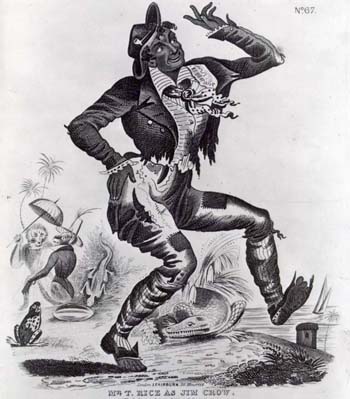
Symbol of Jim Crow, the cork-faced minstrel.
February 10, 2012
In his article, “The Caging of America” in the January 30, 2012 issue of The New Yorker, Adam Gopnik quotes Robert Perkin’s “Texas Tough: The Rise of America’s Prison Empire,” who argues that the South is “the fountainhead of subjugationist discipline.” That is, America’s prison system is a slave plantation, a way of reimposing Jim Crow.
Jim Crow was not the name of an actual person. Rather, it was a stereotype; the name of a rigid racial caste system. But it was more than a series of rigid anti-Black laws enacted from 1876 to 1965. Under Jim Crow, African Americans were relegated to the status of second class citizens and and Jim Crow represented the legitimization of anti-Black racism.
Remember, “The Help” by Kathryn Stockett and later the movie adaptation? While the book and especially the movie are a bit stereotypical and melodramatic, they do provide a somewhat white-washed, somewhat sanitized view of the Jim Crow laws. There is a section in the book where Skeeter, the main white character, is at the library and finds a little booklet titled, “Compilation of Jim Crow Laws of the South.” Skeeter has never seen these laws in print before and is “mesmerized by how many laws exist to separate us.” If you can get over the disbelief that Skeeter, a 22-year old white women born and raised in the South was so naive about Jim Crow laws and the plight of blacks in Jackson, Mississippi, the book is worth reading and the movie worth seeing, especially the performances of Viola Davis and Octavia Spencer, both Academy Award nominees.
The United States has the disgraceful distinction of being the world’s largest jailer with over 2 million incarcerated. We are ahead of Russia and China. And African Americans are disproportional imprisoned due to discriminatory laws, biased enforcement, and sentencing even though white Americans commit crimes at the same rate as people of color. One-in-nine black men aged 20-34 is incarcerated.
In 2007, states spent more than $44 billion on incarceration and related expenses, an increase of 127 percent since 1987, and the cost to states is expected to be an additional $25 billion to 2011. With a faltering economy, states cannot continue this prison growth.
In “Sneak Preview of ‘Slavery By Another Name,'” to be shown on PBS on February 12, the program debunks the idea that slavery ended with the Declaration of Independence. In fact, the enslavement of black Southerners continued under the guise of convict labor — or convict leasing — from the end of Reconstruction to the beginning of World War II and was often as brutal and arbitrary as during slavery. Southern states enacted numerous criminal laws aimed at blacks. For example, it was a crime to be unemployed or to be employed and look for another job without permission and sent back to their employers to work off their debt as convict laborers.
The Thirteenth Amendment to the U.S. Constitution abolished slavery except as a sentence for a crime. Thus, for example, a farmer could not force a black person to work to pay off a private debt, but the state could force a black person to work off fines levied against them, and then the state could sell their labor to farmers and factories. Employers paid the state to lease the prisoners. Thus, those charged with arresting people had an economic interest in arresting more people because their profits increased.
Consider that more than half of all black men without a high school diploma go to prison at some time in their lives. Blacks are now imprisoned seven times more often as whites. There are more black men in prison, on parole, or probation than were in slavery. African Americans go from police harassment to imprisonment, to invisible control where they are prevented from voting, discriminated against, and most likely become imprisoned again.
According to Perkins, “White supremacy is the real principle, . . . [white] racial domination is the real end.” If that is the goal of our prison system, then it is a great success.
Jim Crow is alive and well today.


 The Hunger Site
The Hunger Site
February 11, 2012 at 8:51 am
As far as I can tell, in contemporary America there are 3 different Black experiences.
There are well integrated socially/economically Blacks. They are the Obamas and the Colin Powell’s family. They have good jobs businesses, and money. They don’t have any more participation in the Prison/Industrial complex than their White peers. Maybe 1/3 Black Americans.
There is the inner-city ghetto Black underclass which, right or wrong, is not integrated into the mainstream society. I have read that up to 80% of Black ghetto males wind up in some kind of judicial administration in their teens and 20’s. Maybe 1/3 Black Americans.
There is also an inbetween culture. Some move up, some go down, some stay lateral. The other 1/3.
The point is that Jim Crow and the contemporary Black experience in America is not one dimmensional.